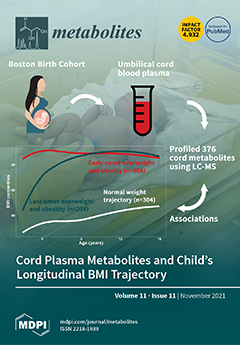Variations in levels of some adipokines, myokines, osteokines, hepatokines and inflammatory cytokines contribute to abnormal glucose and lipid metabolism. The aim of this study was to determine the pattern of adiponectin, osteocalcin (OCN), irisin, FGF-21, and MCP-1 according to the body size phenotype
[...] Read more.
Variations in levels of some adipokines, myokines, osteokines, hepatokines and inflammatory cytokines contribute to abnormal glucose and lipid metabolism. The aim of this study was to determine the pattern of adiponectin, osteocalcin (OCN), irisin, FGF-21, and MCP-1 according to the body size phenotype of middle-aged women, and their associations with BMI, visceral adipose tissue (VAT), and HOMA-IR. A cross-sectional study in 265 women aged from 40 to 65 years was performed. The biochemical characteristics were evaluated in metabolically healthy normal weight, metabolically unhealthy normal weight, metabolically healthy obese, and metabolically unhealthy obese women. There was an association of OCN with BMI (r = −0.107;
p = 0.047); adiponectin with BMI (r = −0.217;
p = 0.001), insulin (r = −0.415;
p = 0.0001), HOMA-IR (r = −0.429;
p = 0.0001), and VAT (r = −0.134;
p = 0.025); irisin with BMI (r = 0.604;
p = 0.001), insulin (r = 0.446;
p = 0.0001), HOMA-IR (r = 0.452;
p = 0.0001), and VAT (r = 0.645;
p = 0.0001); FGF−21 with insulin (r = −0.337;
p= 0.030) and HOMA-IR (r = −0.341;
p = 0.03); and MCP-1 with BMI (r = 0.481;
p = 0.0001), VAT (r = 0.497;
p = 0.001), insulin (r = 0.298;
p= 0.001), and HOMA-IR (r = 0.255;
p = 0.004). A multivariate analysis showed that an elevation of OCN (OR 1.4 (
95%CI 1.06–1.81)) and a reduction of adiponectin (OR 0.9 (0.84–0.96)) were associated factors for a metabolic unhealthy phenotype in normal weight participants. Likewise, higher irisin (OR 1.007 (1.003–1.011)) and MCP-1 (1.044 (1.008–1.083)) were risk factors for a metabolic unhealthy phenotype in woman with obesity. OCN, adiponectin, irisin, FGF-21, and MCP-1 are associated with some metabolic parameters such as BMI, HOMA-IR, and VAT, and could be possible biomarkers of an unhealthy metabolic phenotype in middle-aged women.
Full article






